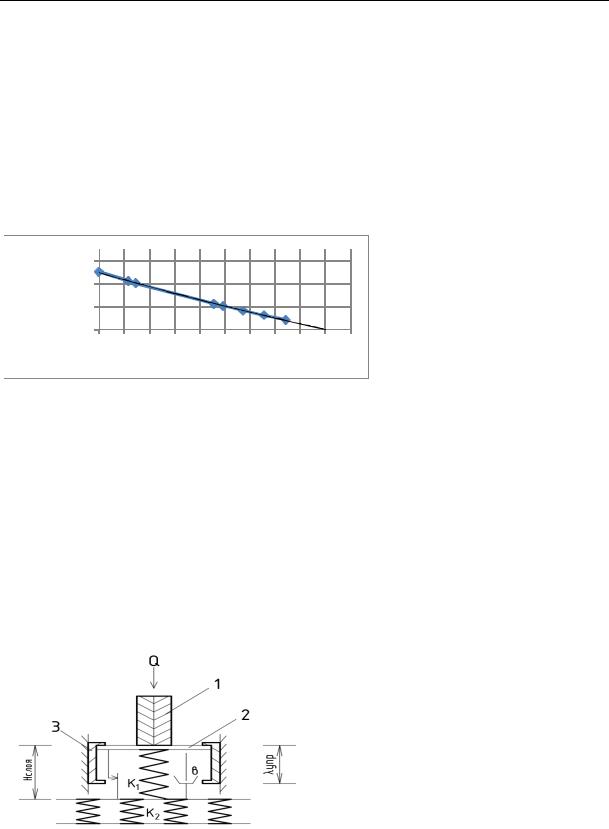
3507
.pdf
Russian Journal of Building Construction and Architecture
9.Mlynchik V. I., Erastov A. E., Vishnevskaya I. A. Metodika opredeleniya potentsiala energosberezheniya i perechnya tipovykh meropriyatii po energosberezheniyu i povysheniyu energeticheskoi effektivnosti [Methodology for determining the energy saving potential and a list of typical measures for energy saving and energy efficiency improvement]. Saint Petersburg, 2001. P. 76.
10.Metodichnі rekomendatsії otsіnki ekonomіchnoї efektivnostі іnvestitsіi v energozberezhnі proekti na pіdpriєmstvakh zhitlovo-komunal'nogo gospodarstva, zatverdzhenі nakazom Mіnіsterstva є pitan' zhitlovokomunal'nogo gospodarstva Ukraїni [Methodological recommendations for evaluating the economic efficiency of investments in energy-saving projects at housing and communal services enterprises, approved by the order of the Ministry of housing and communal services of Ukraine]. No. 218 vіd 14.12.2007.
11.Mishchenko V. Ya., Kolodyazhnyi S. A., Gorbaneva E. P., Ovchinnikova E. V. [Application of algorithms for finding the shortest path in the oriented graph when planning capital repairs of the housing stock] Sb. nauch. tr. RAASN “Fundamental'nye, poiskovye i prikladnye issledovaniya Rossiiskoi akademii arkhitektury i stroitel'nykh nauk po nauchnomu obespecheniyu razvitiya arkhitektury, gradostroitel'stva i stroitel'noi otrosli Rossiiskoi Federatsii v 2018 godu” [Collection of scientific papers of RAASN “Fundamental, search and applied research of the Russian Academy of architecture and construction Sciences on scientific support for the development of architecture, urban planning and construction industry of the Russian Federation in 2018”]. Moscow, Izdatel'stvo ASV, 2019. P. 326––337.
12.Nelyubina O. M., Tolstykh Yu. O., Mikhalina S. S., Uchinina T. V. Sravnenie osobennostei organizatsii kapital'nogo remonta i rekonstruktsii zdanii v Rossii i za rubezhom [Comparison of features of organization of capital repairs and reconstruction of buildings in Russia and abroad]. Sovremennye problemy nauki i obrazovaniya, 2014, no. 5. Available at: http://science-education.ru/ru/article/view?id=15283
13.Prakticheskoe posobie po povysheniyu energeticheskoi effektivnosti mnogokvartirnykh domov (MDK) pri kapital'nom remonte [Praktikoe posobie to improve the energy efficiency of apartment buildings (MMKD during major repairs], 2015, vol. I. P. 89.
14.Povyshenie energoeffektivnosti v MKD [Improving energy efficiency in MCD]. Available at: https://uchet- jkh.ru/publikacii/energo-mkd.html
15.Ob utverzhdenii Instruktsii po opredeleniyu effektivnosti ispol'zovaniya sredstv, napravlyaemykh na vypolnenie energosberegayushchikh meropriyatii : postanovlenie Ministerstva ekonomiki Respubliki Belarus', Ministerstva energetiki Respubliki Belarus', Komiteta po energoeffektivnosti pri Sovete Ministrov Respubliki Belarus' ot 24.12.2003 № 252/45/7 [About approval of the Instruction on determination of efficiency of use of the means directed on performance of energy-saving actions : the resolution of the Ministry of economy of the Republic of Belarus, the Ministry of energy of the Republic of Belarus, Committee on energy efficiency at Council of Ministers of the Republic of Belarus of 24.12.2003 No. 252/45/7].
16.Tsygankov V. M. Energoeffektivnost' i energosberezhenie pri kapital'nom remonte zdanii [Energy efficiency and energy saving during major repairs of buildings]. Energosovet, 2016, no777 1 (43).
17.Energosberegayushchie tekhnologii v stroitel'stve [Energy-saving technologies in construction]. Available at: http://www.informio.ru/publications/id958/Yenergosberegayushi-tehnologii-v-stroitelstve
18.Boosting Building Renovation: What potential and value for Europe? Study for the ITRE Committee, October, 2016. Available at: http:// http://www.europarl.europa.eu/RegData/etudes/STUD/2016/587326/ IPOL_ STU(2016)587326_EN.pdf
40
Issue № 1 (45), 2020 |
ISSN 2542-0526 |
19.Financing Capital Repairs and Energy Efficiency Improvements in Russian Multi-family Apartment Buildings. Available at: http:// https://www.ebrd.com/downloads/sector/sei/capital-repairs.pdf
20.Improving the energy efficiency of apartment blocks. Low Energy Apartment futures( LEAF) Final report. March, 2016. P. 40.
21.Mishchenko V., Gorbaneva E., Ovchinnikova E., Sevryukova K. (2019) Planning the Optimal Sequence for the Inclusion of Energy-Saving Measures in the Process of Overhauling the Housing Stock. Murgul V., Pasetti M. (eds.) International Scientific Conference Energy Management of Municipal Facilities and Sustainable Energy Technologies EMMFT 2018. EMMFT-2018 2018. Advances in Intelligent Systems and Computing, vol. 983. Springer, Cham.
22.Mishchenko V. Ya., Sheina S. G., Gorbaneva E. P. Increase of energy efficiency during overaul of housing stock in Russian Federation. IOP Conf. Series: Materials Science and Engineering 481 (2019) 012031, Safety 2018, IOP Publishing. doi:10.1088/1757-899X/481/1/012031.
23.National and EU Policy Recommendations Recommendations for local, national and EU policy on retrofitting multi-occupancy, mixed tenure buildings. FULL REPORT. February, 2016. P. 76.
24.Project: Energy saving and economic optimization of energy efficiency renovation measures for multi-storey buildins from the 1079s. Available at: https://lnu.se/en/research/searchresearch/forskningsprojekt/project-energy- savings-and-economic-optimization-of-energy-efficiency-renovation-measures/
25.Vatin, Nikolai & Nemova, Darya & Ibraeva, Yulia & Tarasevskii, Philipp. Development of Energy-Saving Measures for the Multi-Story Apartment Buildings. Development of Energy-Saving Measures for the MultiStory Apartment Buildings. Applied Mechanics and Materials. (2015). 725-726. 1408-1416.10.4028/www.scien- tific.net/AMM.725-726.1408.
41

Russian Journal of Building Construction and Architecture
DESIGNING AND CONSTRUCTION OF ROADS,SUBWAYS,
AIRFIELDS,BRIDGES AND TRANSPORT TUNNELS
DOI 10.25987/VSTU.2020.45.1.004 UDC 625.7/8
M. E. Piletskii1, K. A. Andrianov2, A. F. Zubkov3
INFLUENCE OF THE LOAD-CARRYING CAPACITY OF VEHICLES WHEN PERFORMING REPAIR WORKS OF ROAD PAVEMENTS BY MEANS OF THE JET-INJECTION METHOD
Tambov State Technical University 1, 2, 3
Russia, Tambov
1 PhD student of the Dept. of Urban Construction and Highways, tel.: +7 (4752) 63-09-20, 63-03-72, e-mail: gsiad@mail.tambov.ru
2 PhD in Engineering, Assoc. Prof., Head of the Dept. of Urban Construction and Highways, e-mail: gsiad@mail.tambov.ru
3 D. Sc. in Engineering, Prof. of the Dept. of Urban Construction and Highways, e-mail: gsiad@mail.tambov.ru
Statement of the problem. Upon the completion of repair works to eliminate defects such as potholes on non-rigid surfacing, traffic flow starts with no consideration given to the properties of a bitumen-mineral mix and load-carrying capacity of a traffic flow, which leads to the failure of the material in a surfacing pothole when applying the jet-injection method.
Results. The results of experimental studies on the effect of load on the rheological characteristics of bitumen-mineral mixtures are presented. The regularities between the strength and rheological characteristics of the bitumen-mineral mix taking into account the thickness of the mixture layer are established. According to the results of the experiment, the dependence of the compaction coefficient of the bitumen mineral mixture on the layer deformation under the action of the transport load was established. There are some restrictions on the carrying capacity of vehicles on the repair areas of a surfacing during the formation of the structure of the pothole material.
Conclusions. It is proved that the use of the jet-injection method in pothole repairs of a non-rigid surfacing does not provide the required characteristics of the material after it has been laid. To improve the quality of repairs, an additional compaction of a laid mixture in a pothole using vibration plates or vehicles with axial load limitation during the formation of the material structure in a pothole is required taking into account the properties of the bituminous mineral mix.
Keywords: jet-injection method, bituminous mineral mix, characteristics of a mix, transport load.
Introduction. An annual increase in the number of vehicles causes a surge in traffic accompanied by larger axial loads on pavements, which contributes to defects on non-rigid coatings
© Piletskii M. E., Andrianov K. A., Zubkov A. F., 2020
42
Issue № 1 (45), 2020 |
ISSN 2542-0526 |
taking the form of potholes. In order to increase the service life of pavements and ensure traffic safety, timely maintenance of pavements is needed. Otherwise there might be deterioration of surfacing thus requiring costly work to be performed in order to restore it [1––5, 7].
Presently, the most common way to eliminate defects occurring in non-rigid pavements taking the form of potholes is use of the jet-injection method, which is cost-efficient in terms of the amount of preparation needed. This method is referred to as a high-speed (operational) repair one: it takes much less time for work to be performed as opposed to traditional methods for patching surfacing (by means of cast and hot mixes). It has been found that from an economic standpoint, application of this method is more profitable compared to other methods of repairing potholes of a non-rigid surfacing [9––11, 13––20].
This method used to eliminate defects on non-rigid surfacing taking the form of chipping particles of the mix off a surfacing, sealing cracks and potholes with the depth of 0.01––0.02 m provides the required strength characteristics of the material in relation to transport loads.
It is generally considered that the advantage of the jet-injection method is the absence of a compaction process following laying of the material into a pothole of a roadway surfacing. To prove that, there is a fact that the bitumen-mineral mix (with the size of fractions from 2.5 to 10 mm) is fed into the pothole at the speed of 30––32 m/s from the height from a surfacing of 0.6 m and due to the energy of the particles there is a uniform and dense distribution and compaction of the laid material in the pothole.
The practical application of this method for repairing potholes that are more than 0.03 m deep has shown that due to the properties of the bitumen-mineral mix, heavy deformations cause plastic deformations in the laid layer of the material, which causes a decrease in the quality of repairs [6, 8].
1. Effect of traffic flow on the strength characteristics of the material inside the pothole. In order to identify the effect of heavy traffic loads on the strength characteristics of the material inside the pothole of a surfacing, samples were taken from surfacing areas where potholes were repaired using the jet-injection method in 2014 and 2015. Visual inspection revealed no external damage on the surface of the repaired potholes. It was found that the compressive strength of the samples ranged from 1.12 to 1.56 MPa, which was below the minimum value as required by GOST (ГОСТ) 9128-2009. The tensile strength of the samples at the temperature of 20 ºС corresponded to the compressive strength from 2.1 to 2.3 MPa, which meets the requirements of the GOST under discussion. Based on the results, it can be concluded that compaction of the bitumen-mineral mix even under transport loads does not always ensure a required density.
43

Russian Journal of Building Construction and Architecture
At the stage of the preparation of the bitumen-mineral mix, in order to ensure required characteristics of asphalt concrete in a surfacing pothole, the optimal granular and metric composition of crushed stone grains of the fraction of 2.5––10 mm was selected with a grade of at least 1200, wear grade I-1 and the content of dusty and clay particles not more than 1 %. As a cementitious material, a rapidly decaying cationic bitumen emulsion in a 60 % concentration (EBK-1), was employed. The optimum temperature of the bitumen emulsion was taken to be 71––80 °С. In order to identify the effect of traffic intensity and axial vehicle load on the result of repairs to eliminate defects on non-rigid surfacing by means of the jet-injection method, a serial computercontrolled road machine Madrog Madpatcher was used (Fig. 1). The studies were carried out in during repairs of potholes on non-rigid pavements of the R-22 Caspian highway.
Fig. 1. Road machine
Madrog Мadpatcher
To ensure a specified layer thickness while laying the bitumen-mineral mix in the pothole of the pavement and to eliminate the influence of an uneven base of the pothole on the characteristics of the material during compaction caused by the movement of transport, the place of laying the mix was milled with a cold mill. Following the milling, the surface of the pothole was cleaned with an air stream under pressure and then the mix was laid by means of the jetinjection method (Fig. 2).
Fig. 2. Preparation of the area for the pothole repairs and filling it with the mix
44

Issue № 1 (45), 2020 |
ISSN 2542-0526 |
The thickness of the mix layer in the pothole was taken to be 0.05 m. The compaction coefficient of the material in the surfacing pothole following laying of the mix and during the movement of vehicles was identified by means of the non-destructive method using the PAB-1 densitometer, which makes it possible for the material density and compaction coefficient to be determined following the loading.
The movement of transport in the repairs site was recorded automatically as shown in Fig. 3.
Fig. 3. Transport flow in the surfacing repairs site
It was found that following the laying of the mix in the pothole of the surfacing by means of the jet-injection method, the compaction coefficient is 0.81––0.83. When the vehicle is in motion, the compaction coefficient has different values depending on the axial load. After a number of cars (up to 6m) have passed, small trucks (6––9 m), and trucks (9––13 m), the value of the coefficient increases to unity, and after heavy vehicles have passed, it decreases. 10 hours following the repairs, the compaction coefficient of the material in the pothole was 0.85. The tests of the material samples taken from the repairs 60 days later showed a compaction coefficient of 0.96 and water saturation in percentage by volume of 9.3, which does not meet the requirements of the GOST (ГОСТ) 9128-2013.
The traffic flow from 9 am to 7 pm ranged from 680 to 800 cars per hour. The analysis of the traffic flow according to the load-carrying capacity showed that the share of heavy vehicles was 30––40 % of the total number of the vehicles.
2. Determining the rheological characteristics of the bitumen-mineral mix. Unlike the hot asphalt mix, the structure of the bitumen-mineral mix laid in the pavement pothole takes a relatively long time to form [10]. When a vehicle is moving under the influence of stresses in the contact zone of the tire with the compacted surface of the material, the stress is transferred from the tire to the surface of the laid mixture in the surfacing pothole. Depending on the contact stress and the properties of the material being compacted, both an increase in the coeffi-
45

Russian Journal of Building Construction and Architecture
cient of compaction of the material and its decrease will take place. The ability of a material to absorb an external load without destroying the layer is characterized by means of the elastic modulus Еу. When compaction of the material associated with the development of irreversible deformation and the formation of a strong structure, the properties of the material are characterized by means of the deformation modulus Ед and the elastic coefficient Кж.
In order to establish the rheological characteristics of the bitumen-mineral mix, studies were carried out. As a result, the numerical values were obtained of the stiffness coefficient Кж, N/mm, and the coefficient of viscous resistance Кв, Ns/mm, from the load at different layer thicknesses.
It has been experimentally proved that in the zone of contact of the tire with the surfacing due to the stresses under the car tire, material deformation takes place. Depending on the contact stress and the properties of the material, both elastic deformation and plastic deformation can occur, which characterizes fracture process. Exceeding contact stresses in relation to the tensile strength of the material causes a decrease in the strength of the mix layer and a decrease in the stiffness coefficient of the mixture. Fig. 4 shows the change in the coefficient of rigidity of a bitumen-mineral mix from deformation obtained experimentally when loading a layer of a mixture with the thickness of 0.07 m2.
Coefficient |
stiffness, N/mm |
|
of |
Fig. 4. Dependence of the stiffness coefficient on the deformation
Deformation, mm
The data in Fig. 4 shows that with as the strain of the mixture layer increases under the load, so does the stiffness coefficient of the mix layer. Moreover, the stiffness coefficient of the mix increases up to a certain value, then decreases. The process of the decrease in the stiffness coefficient is indicative of the development of plastic deformation, i.e., the start of fracture process. The numerical value of the stiffness coefficient of the mix from deformation of the material under the load can be given by the formula:
Кж 0.009 3 0.099 2 0.193 0.18, |
(1) |
where λ is the deformation of a material layer, mm. The coefficient of the equation correlation is 0.99.
46

Issue № 1 (45), 2020 |
ISSN 2542-0526 |
It was experimentally proved that there are some patterns in the characteristics of the material that are critical to its response to external loads Еу, Ед, Кж as shown in Fig. 5.
Elasticity modulus, MPa
а)
2
 1
1
Coefficient of stiffness, N/mm
Deformation modulus, MPa
b)
1
2
Coefficient of stiffness, N/mm
Fig. 5. Dependence of the elasticity modulus (a) and the deformation modulus (b) on the stiffness coefficient of the mix layer: 1 is the thickness of the layer of 0.05 m; 2 of 0.07 m
The analysis of the data presented in Fig. 5 enabled us to conclude that there are certain dependencies between the parameters Еу, Ед and Кж. If there is a slight change in the thickness of the layer, the deformation modulus of the material being compacted is less dependent on the stiffness coefficient of the mix in relation to the elastic modulus. In order to identify the general patterns of the characteristics of the mix (Еу and Кж), we take the elastic moduli at a material layer with the thickness of 0.05 m per unit and denote the obtained relative value using the coefficients of the influence of the layer thickness on the elasticity modulus and deformation modulus (Fig. 6).
Coefficient of the layer thickness
Fig. 6. Dependence of the coefficient Кн on the stiffness of the surfacing layer for different thicknesses of the surfacing layer
Coefficient of stiffness, N/mm
The numerical value of Кн is given by the formula:
Кн =132.5Н2 -82.9Н +13.96, |
(2) |
where Н is the thickness of the compacted layer of the bitumen-mineral mix, m. The coefficient of the equation correlation is 1.0.
47

Russian Journal of Building Construction and Architecture
Fig. 6 suggests that as the stiffness coefficient of the mix increases above 0.25, the stiffness coefficient stabilizes and remains constant (1.0). The dependences for determining the elastic modulus and the deformation modulus of the material on the stiffness coefficient are as follows:
Еу = Кн (278.95Кж -35.7), МPа; Ед =67.1 Кж +0.8, МPа. |
(3) |
The coefficient of the equation correlation is 0.99. Based on the experimental data obtained during the repairs by means of the jet-injection method, the dependence was found between the deformation of the surfacing pothole material and the coefficient of compaction (Fig. 7).
Coefficient of compaction
Fig. 7. Dependence of the coefficient of compaction on the deformation
of the bitumen-mineral mix in the pothole
Deformation of the surfacing, mm
The numerical value of the coefficient of the compaction of the mix on the deformation of the mix during compaction can be given by the formula:
(4)
where λ is the deformation of the surfacing pothole material, mm. The coefficient of the equation correlation is 0.999.
3. Modeling the process of interaction of the tire with the pothole surface. In order to determine the strain of the mixture under the load from the vehicle tire, a rheological model is considered as shown in Fig. 8.
1 is a pneumatic tire;
2 is a compacted bitumen-mineral mix;
3 is a weightless seal modelling the residual deformation of the material
Foundation
Fig. 8. Rheological model of compaction of the bitumen-mineral mix in the roadway surfacing pothole of the with a pneumatic tire: Q is the gravity transmitted from the vehicle to the tire, kN;
K1 is the coefficient (modulus) of material stiffness, N/mm; К2 is the stiffness coefficient of the base, N/mm; λупр is the deformation (movement of a weightless plug), characterizing the elastic deformation of the material, mm
48
Issue № 1 (45), 2020 |
ISSN 2542-0526 |
When the vehicle is in motion, the force Q which characterizes the axial load that acts on the material in the surfacing pothole. Under the axial load in the contact zone of the tire with the surface of the material, stresses occur that contribute to the development of deformation of the material. The initial conditions for the motion of the surface and cork are as follows:
t =t0 ; x1 =0 ; x2 =0. |
(5) |
As the deformation of the material layer progresses beyond the elastic deformation, a weightless seal moves which characterizes the complete deformation of the material under the load х2. This condition takes the following form:
x1 упр, mm. |
(6) |
When removing the load, the surface of the material layer due to elastic deformation moves up till it reaches the upper stopper of the tube. The lifting speed of the surface depends on the speed of unloading of the material and is determined by the speed of the vehicle. The proposed rheological model allows us to represent it as a mathematical model described by an equation relating stresses and strains that take place simultaneously due to the load application:
Кж , |
(7) |
where Кж is the coefficient of stiffness, N/mm; λ is the deformation, mm; η is the viscosity, Ns/mm.
This dependence taking into account the deformation of the material and the rheological characteristics of the mix can be as follows:
/ Кж / , mm. |
(8) |
According to this dependence, the σ/Кж ratio characterizes the elastic deformation of the material and σ/η the residual deformation. As the load is applied again and again, the residual deformation is given by the dependence [11]:
ост n tн / , |
(9) |
tн is the total load effect on the material, s; n is the number of the loading cycles.
In order to calculate the deformations of the bitumen-mineral mix in the roadway surfacing pothole under the contact axial stresses from vehicles, a software package was developed [12]. The calculation of the mix deformation under the load of 0.6 MPa and the stiffness coefficient of 0.13 is presented in Fig. 9.
Fig. 10 shows the results of modeling the deformation of the bitumen-mineral mix in the roadway surfacing pothole on the stiffness coefficient of the mix depending on the axial load of vehicles (according to GOST R (ГОСТ Р) 52899-2007).
49
